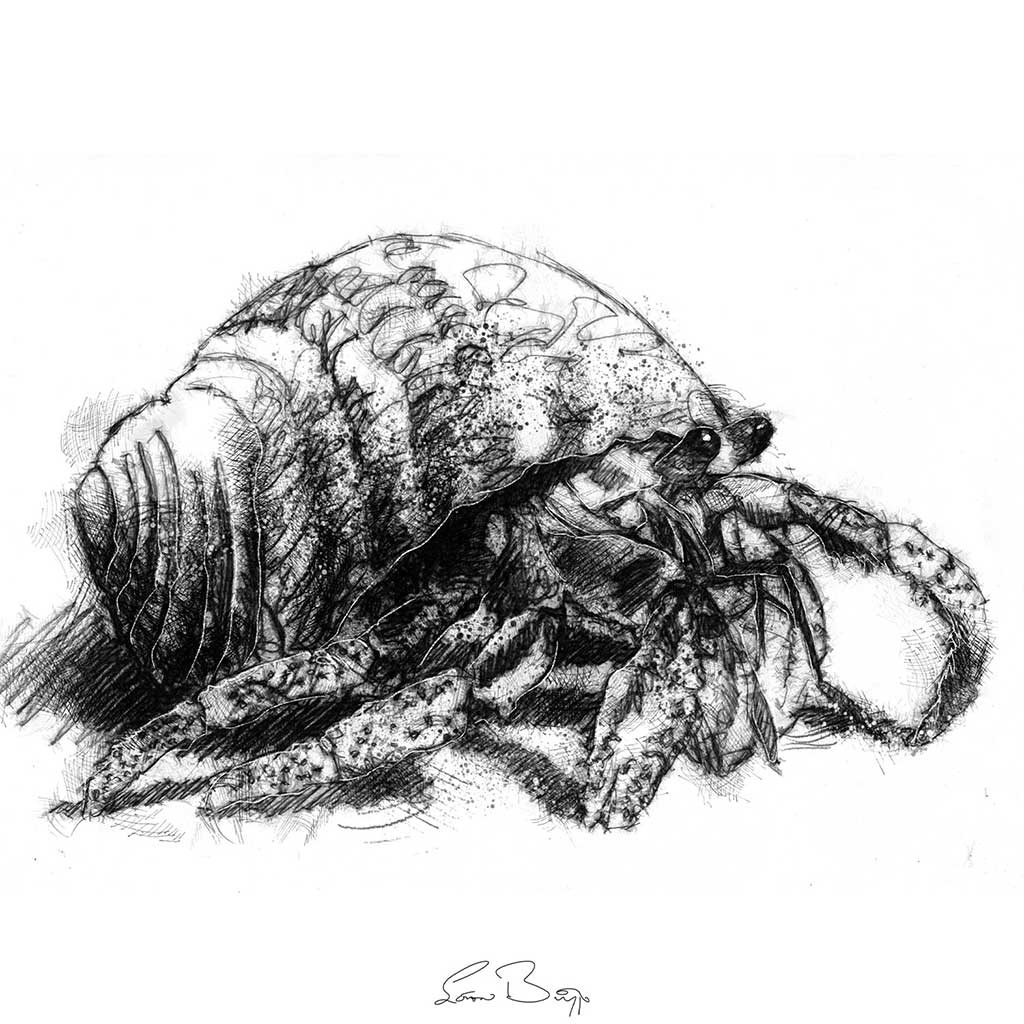1,875 Words on Hermit Crab Essays:
Move your readers with a unique (and simple) storytelling technique that breaks the mold and stands out on Substack

Hey there,
In my last post, Missed Connection: NYC Ferry Astoria Route, I used a writing technique called the "Hermit Crab Essay."
In this post, I’ll break down this technique so you can use it to craft short, meaningful stories that stand out on Substack and impress new readers. I’ll cover what Hermit Crab Essays are, how I approach them, offer a few powerful tips, and share some of my favorite examples in fiction.
Sound good?
Let’s dive in :)
What is a Hermit Crab Essay?
A Hermit Crab Essay is a story—whether fiction or nonfiction—that adopts a pre-existing form (not typically used for essays or short stories) as its framework. The structure serves as a shell for the narrative, much like a hermit crab finds shelter in discarded shells.
For example:
A story about addiction told through a grocery list.
A story about an abusive relationship written as a missed connection on Craigslist.
A story about infidelity presented through a customer service email.
The term was coined by Brenda Miller and Suzanne Paola in their book Tell It Slant: Writing and Shaping Creative Nonfiction. It’s a creative technique that blends the familiar with the unfamiliar, adding intrigue and novelty by using the chosen form’s inherent structure to shape the narrative.
4 Examples of Hermit Crab Essays in Fiction
“Hermit Crab Essays” was originally coined as a technique used for nonfiction, and specifically, personal essays. But the same technique can easily be applied to fiction and short stories. Here are some of my favorites:
Ernest Hemingway: Baby Shoes
For Sale: Baby Shoes, Never Worn.
That’s it. That’s the whole story.
Widely regarded as the shortest short story ever written, Hemingway’s "Baby Shoes" is also an example of a Hermit Crab Essay. It takes the form of an ad headline—just six words—but its simplicity carries layers of meaning. The more you think about it, the more the story unfolds:
Who posted the ad?
Why did they buy baby shoes?
Why are they selling them?
Why haven’t they been worn?
Is this about a miscarriage or a desperate financial situation?
“Baby Shoes” is also a great example of Hemingway’s iceberg theory—where the story’s depth is implied, with only the “tip of the iceberg” revealed to the reader. This style is often found in Hermit Crab Essays, where the chosen form leaves much beneath the surface.
BJ Novak: Missed Connection: Grocery spill at 21st and 6th 2:30 pm on Wednesday
Missed Connection: Grocery spill at 21st and 6th 2:30 pm on Wednesday
“I was outside the Trader Joe's at 21st and 6th at around 2:30 pm last Wednesday.
I was wearing oversized sunglasses and a small straw fedora hat, light blue jeans, a black t- shirt- like top, and had freshly washed shoulder- length dirty blond hair with bangs. I'm 29 but people sometimes guess I'm anywhere from 28 to 30. I was carrying two paper grocery bags. You were walking by me in the opposite direction, carrying groceries, too, but only one bag. You asked if you could help and when I tried to explain that then your hands would be just as full as mine, I dropped a bottle of salsa, red, medium spicy Trader Joe's brand (or Trader Jose's, as you corrected me) but it didn't shatter which we both found interesting.
I told you my name was Lila (L-I-L-A) and you told me you had a cousin who pronounced it the same way but spelled it differently (L-E-I-L-A)…”
This story, presented as a Craigslist Missed Connection, tells a quick, relatable, modern-day tale of unrequited love.
You can find the full piece in Novak’s One More Thing: Stories and Other Stories.
Fun fact: Novak’s story inspired me to write Missed Connection: NYC Ferry Astoria Route. Remember, it’s okay to borrow techniques from other writers as long as you add your own spin. The essence of storytelling is telling old stories in new ways and new stories in old ways :)
Nicolas Marconi: A Recipe For You in The New World
In a cracked clay pot on a tenement stove, combine in equal measure:
Anardana, imported to America like your parents.
Aniseed, for your unappreciated sweetness.
Cacao, raw and bitter as the laughter of the bigots mispronouncing your name.
Ginger, to stoke the unyielding fire in your eyes.
Peppermint, an uplifting balm for the weariness of living in a place not made for you.
Vanilla, because your flavor is deeper than slurs and stereotypes.
Simmer with the love of your ancestors for a thousand years until you boil over. Don’t worry about the mess.
This is another example of a powerful story packed into a short word count.
Marconi entered it in the 100-Word Challenge for NYC Midnight, a global writing contest I’ve entered many times. In fact, my "Missed Connection: NYC Ferry Astoria Route" was one of my recent entries.
Marconi won the contest.
I placed fourth in my group.
: The Escape Room Emails
Please note: I wasn’t able to find an excerpt of this one online, but I was able to find a synopsis from The LA Review of Books:
“[Keret writes] an email exchange between a young man, who wants to bring his Holocaust-survivor grandmother to an escape room on Holocaust Memorial Day, and the owner of that escape room, who tries to explain that his business is closed on that day, is interspersed throughout the latter half of the book…
…At one point, a story that ends with the phrase, “I’d like to thank her again,” gives way to an email addressed to the escape room owner, beginning, “Dear Sefi, I would like to thank you again…”
Etgar Keret is one of my favorite writers.
His ability to pack so much meaning into such a small space has been a huge inspiration to me, especially how he blends humor with deeply moving stories about the human condition. If you haven’t noticed, I added a link to his Substack above.
You should definitely check him out—and absolutely read his books.
My favorite is Fly Already.
How I Approach Hermit Crab Essays
Step #1: Start with an Idea
Before writing anything, I always start with an idea.
This could be a prompt, a character, an ending, a plot point, an emotion, or a theme. It doesn’t have to be set in stone—it can evolve as the story takes shape.
The point is to get started and let that initial idea guide your next creative step.
Step #2: Make Connections
Creativity is about making connections.
In my short story “Missed Connection: NYC Ferry Astoria Route,” I knew I needed to write a drama that took place on a ferry and somehow involved a charcuterie board. When I thought about the charcuterie board, I envisioned a diverse plate of meats and cheeses from different countries.
That idea connected to something my character, Isabelle, longed for: wanderlust, a desire to escape her abusive relationship and rediscover herself.
Step #3: Let Constraints Determine the “Inevitable”
Think about your constraints (ferry, missed connection, drama, charcuterie board, etc.) and the inherent properties of your constraints—whether it’s the form, setting, or ideas you’ve already fleshed out. What kind of story, events, or character arcs naturally align with them?
This will make your story feel both surprising and inevitable.
For example, when I thought about the ferry, I saw it as a liminal, temporary space. This idea connected to the theme of liminal, temporary love, a common thread in drama, which led me to use the "Missed Connection" format for my story. The ferry’s repetitive route also symbolized a cycle—something I paralleled with the cycle of abusive relationships, aiming to take readers through that journey as well.
Before I knew it, I was writing a Hermit Crab Essay without even realizing it.
Here are 50 “Shells” to Start Your Hermit Crab Essay.
Customer Complaint Email
Grocery List
Resume
Missed Connection
Reddit Thread
Google Review
Obituary
Recipe
Job Rejection Letter
Apology Letter
Text Message Thread
Product Instruction Manual
Auction Listing
College Application Essay
Breakup Letter
Weather Report
Classified Ad
Wedding Invitation
Airline Safety Instructions
Spotify Playlist Notes
Personal Diary Entry
Emergency Evacuation Plan
Museum Exhibit Label
Travel Brochure
Horoscope
Fortune Cookie Message
Police Report
Medical Bill
Restaurant Menu
Facebook Event Invitation
Movie Review
Real Estate Listing
Annual Holiday Newsletter
To-Do List
Public Apology Statement
LinkedIn Recommendation
Dating App Profile
Online Shopping Cart
Performance Review
Anonymous Postcard
Prescription Drug Label
Wedding Vows
Conference Agenda
Handwritten Thank You Note
Court Transcript
Lost and Found Poster
Eulogy
Instructional Pamphlet
Field Trip Permission Slip
Airline Lost Luggage Form
4 Tips for Writing Hermit Crab Essays
Hermit Crab Essays are all about using creative constraints to tell an unexpected story. Before you get started, here are four tips I always keep in mind:
Tip #1: Write Implicitly
When writing a Hermit Crab Essay, don’t give away every detail. Your words need to work harder, implying deeper meaning through subtext. This makes the reader part of the story, creating a more engaging experience. Implicit writing is my favorite because it’s conversational—the reader fills in the gaps, which is far more rewarding than being spoon-fed every detail.
Tip #2. Write Your Story Outside the Form
Your first draft doesn’t need to fit into the chosen form right away.
I find it easiest to brain dump all the details into a formless document, telling myself the story. Once you have everything out, you can simplify it and find the right structure that fits the form of your Hermit Crab Essay.
Tip #3: Form Follows Character
The form you choose should say something about your character.
It doesn’t have to be a profound connection, but it should make sense. Hemingway’s choice of an advertisement for “Baby Shoes” tells us the character is a victim of misfortune, possibly desperate for money. In my “Missed Connection” story, the format immediately tells the reader that Felix is desperately searching for Isabelle, which adds intrigue and sets up an inevitable twist.
Tip #4: Add a “Negative Character”
This might be a term I made up, but it’s useful.
A “negative character” is someone who isn’t explicitly present in the story but is still central to it. Their story is told through the perspective of another character. In my case, Isabelle’s story is told through Felix’s eyes. Though Felix is the narrator, Isabelle is the real protagonist. I used Felix’s perspective to show her emotions, decisions, and thought process, leading the reader to realize they were rooting for her all along—not Felix.
This mirrors a theme in abusive relationships, where a charming, seemingly charismatic partner is later revealed to be obsessive and abusive.
And that’s it :)
I love Hermit Crab Essays.
They’re such a simple way to stumble on your most creative ideas and write stories that feel unconventional and moving. Why? Because they make it easy to:
Blend the familiar with the unfamiliar
Add guidelines that lead to more “obvious” creative decisions.
Create a more interactive and thought-provoking experience.
So go ahead—experiment, surprise your readers, and let your story take shape in unexpected ways. Be sure to reach out with questions, and let me know how you’re progressing with your story. I’d love to see what you come up with.
Hope this helps,
Jake








Saving this!! Fantastic advice, and was fun to read this in your friendly voice.
Nonfiction forms add authority and believability to fiction. Plus the constraints always create things that would have otherwise been unavailable.
The newsreel at the beginning of Citizen Kane. It establishes authority, but also tells us all of the major plot points, which allows us to disengage from following the plot, and engage more with the emotion of the story as it progresses.